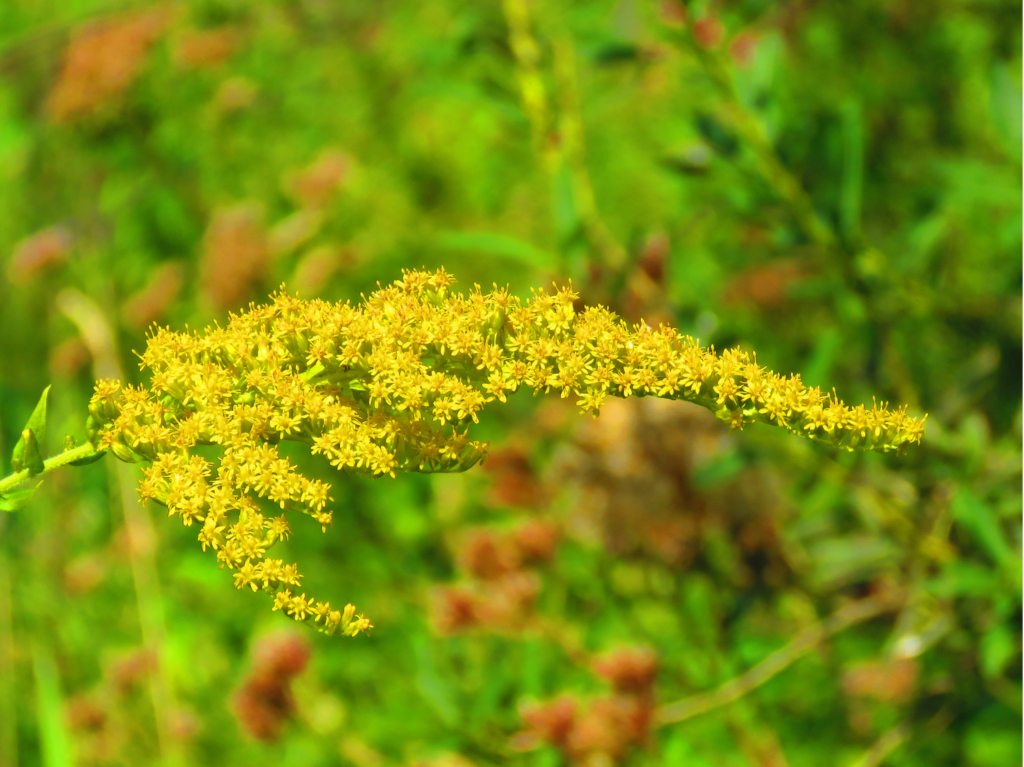By Kathy Abascal
As I write, goldenrod is blooming in various spots along Vashon roads. There are hundreds of goldenrod species across the world; the one most frequently found in the northwest is Solidago canadensis, but there are a few other varieties. John Trelawny, author of “Wildflowers of the Pacific Northwest,” notes that it is challenging to identify the exact species, but fortunately, the various species appear to have similar medicinal attributes.
According to the Eclectic physicians, who practiced in the late 1800s and early 1900s, the various goldenrod species have very different fragrances and degrees of astringency. They mostly used a sweet-scented goldenrod growing back east that was said to smell a bit like anise and sassafras, which sounds lovely to me. Out here, they described our canadensis species as having more of a pine scent. I am soon heading out to verify this information!
Based largely on European usage, goldenrod flowers and leaves are today known as excellent diuretics. According to Rudolf Weiss (a German physician and herbalist), goldenrod is the most reliable and potent herbal diuretic there is. He used it as an aid in high blood pressure and urinary tract issues, in the latter for both infections and bladders that were simply irritated. Preliminary research confirms that the plant has a degree of analgesic (pain-relieving) and anti-spasmodic effects in the bladder. As well, some practitioners think it can be used to help prevent kidney stones from forming.
In Europe, goldenrod was also one of the primary herbs used to calm and treat upper respiratory tract infections. Goldenrod seems to quiet symptoms generated as the immune system reacts to an infection, and probably also has some antimicrobial effects. But this aspect has not been well-studied, and is probably not as strong in that regard as herbs such as the Echinacea species.
Daniel Moerman, in his book, “Native American Ethnobotany,” reports that the many species of goldenrod found in North America were used by tribes across the country for a variety of ailments. Most commonly, a tea of the leaves and flowers was used for skin issues ranging from burns, to sores (on both horses and humans), to boils. The plant was also often used for certain fevers and diarrhea.
Many tribes used the roots for sore throats, fever, and colds, with root poultices applied to boils. One fact I found very interesting was that the Omaha tribe had a “floral calendar.” While on their summer hunt for buffalo, the blooming of goldenrod told them that their corn was beginning to ripen at home.
In their practices, the Eclectic physicians primarily used goldenrod to quiet flatulence and upset stomach and favored it as tea for those recovering from difficult intestinal ailments such as dysentery, cholera, and diarrhea. But they also used goldenrod flowers for a variety of urinary issues because of its strong diuretic effect. The Eclectics also used goldenrod for wounds, based on knowledge gained from Native American tribes.
Although many mistakenly think goldenrod causes seasonal allergies, it does not. Its pollen is too heavy to become airborne, and goldenrod can in fact be used to quiet the runny nose and itchy eyes of seasonal allergies that are usually caused by the blooming of ragweed. On Vashon, ragweed blooms along our beaches at about the same time that goldenrod blooms (August and September), and is the likely cause of the symptoms that goldenrod can be used to treat, but is often blamed for causing.
Dried goldenrod flowers and leaves are best prepared as a gently steeped tea. The Eclectics warned that the plant should not be boiled, as that would disperse the volatiles that give the plant its scent and many of its important medicinal properties.

